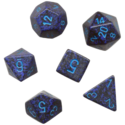
Back ЛАРП Bulgarian Larp Czech Чĕрĕлле иртерекен сăнарлă вăйăсем CV Liverollespil Danish Live Action Role Playing German Duonreala rolludo Esperanto Rol en vivo Spanish Larp Estonian Live-roolipelaaminen Finnish Jeu de rôle grandeur nature French
| Part of a series on |
| Role-playing games |
|---|
 |
| Types |
| Movements & Traditions |
| Parts of Games |
| Participants |
| Lists |
|
|

A live action role-playing game (LARP) is a form of role-playing game where the participants physically portray their characters.[1] The players pursue goals within a fictional setting represented by real-world environments while interacting with each other in character. The outcome of player actions may be mediated by game rules or determined by consensus among players. Event arrangers called gamemasters decide the setting and rules to be used and facilitate play.
The first LARPs were run in the late 1970s, inspired by tabletop role-playing games and genre fiction. The activity spread internationally during the 1980s and has diversified into a wide variety of styles. Play may be very game-like or may be more concerned with dramatic or artistic expression. Events can also be designed to achieve educational or political goals. The fictional genres used vary greatly, from realistic modern or historical settings to fantastic or futuristic eras. Production values are sometimes minimal, but can involve elaborate venues and costumes. LARPs range in size from small private events lasting a few hours, to large public events with thousands of players lasting for days.
- ^ (Tychsen et al. 2006:255) "LARPs can be viewed as forming a distinct category of RPG because of two unique features: (a) The players physically embody their characters, and (b) the game takes place in a physical frame. Embodiment means that the physical actions of the player are regarded as those of the character. LARP participants may dress in the costume of their character and carry appropriate physical props (e.g., an 18th century militia LARP participant may wear a military uniform and carry a musket). Whereas in a RPG played by a group sitting around a table, players describe the actions of their characters (e.g., "I run to stand beside my friend"); in an equivalent situation in a LARP, a player would physically run to the appropriate point within the game space."